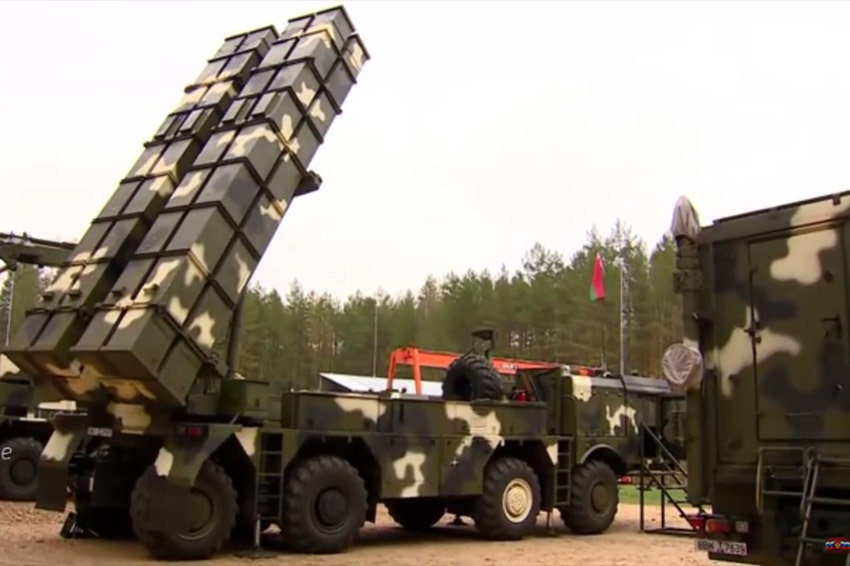Developing missile technology is Belarus’ strategic priority
 The situation has not changed
The situation has not changed

Belarusian missile programme relies on foreign technology and has a long history. The multiple launch rocket system (MLRS) Polonaise is the first result of years of hard work. In addition to military significance as a means of strategic deterrence, it plays an important political role, strengthening Belarus’ independence. Minsk has ambitions, which extend beyond own heavy multiple launch rocket system. Hence, Belarus is likely to display other missile systems in the near future.
On June 16th, 2016, President Lukashenka announced that the MLRS Polonaise trial run was a success. The Belarusian leader hailed the event as a happy day for the national security of Belarus. He added that it took only two years to create the new weapon and modest funds. During the trial, the weapon has demonstrated high accuracy of reaching the target (up to 10 m). The results of the trial have clearly inspired Lukashenka, who called it the greatest achievement.
The MLRS Polonaise was on the public display for the first time in 2015. The first combat missile launches were carried out in China: Belarus simply has no testing ground for probing missiles with 200 km maximum range. The Belarusian authorities have acknowledged that China donated technology for the Polonaise. Otherwise, Belarus would be unable to create the missile industry ‘from scratch’, due to the complete lack of scientific and industrial capacity.
That said, Belarus also studied the experience of other countries, which produced similar weapons, including Turkey.
Turkey’s experience in heavy MLRS is very relevant in terms of Belarus’ experience with the Polonaise. Since the early 90-ies of the last century, Turkey has been negotiating with several countries regarding the purchase of missile technology. China offered the best conditions. In 1997, a Turkish company Roketsan signed an agreement with Chinese firm CPMIEC on joint development and production of MLRS Kasirga based on Chinese technology. The first tests were carried out in Turkey in 2000. This means, that Minsk and Beijing have concluded a similar agreement sometime around 2013. However, the organizational phase, associated with elaborating the terms of reference for new weapons, financial planning, finding a potential partner, negotiating and reaching a political agreement, and establishing the production base must have taken much more time. It is very likely that the process started in 2007, i.e. 9 years ago.
The overall timeframe of the project implies its strategic nature, hence, the overall enthusiasm of Lukashenka about the successful trial of the MLRS Polonaise in Belarus.
The stated accuracy (deviation by 10 meters at 200 km) implies there is the shell correction system on the final trajectory of the missile. An uncontrolled missile launched on a ballistic trajectory is influenced by a number of objective factors, which, in principle, would not allow achieving a direct hit on the target, the Earth’s rotation being one of them. That said, the Soviet uncontrolled ballistic missile Luna-M launched at maximum distance of 70 km was accurate by up to 700 m, i.e. 1% of the launch range. Iranian uncontrolled ballistic missiles have similar accuracy. Hence, Belarus is working on high-tech weaponry.
Since there are no official reports, it is difficult to assess the costs of the MLRS Polonaise development and production. That said, the development, creation and delivery of Ukrainian operational-tactical missile ‘Korshun’ was estimated at USD 800 million. In any case, the cost of license and technical documentation to establish the production of the MLRS Polonaise was tens of millions of US dollars. So together with setting up the required production capacity, the overall cost of the Belarusian Polonaise could be quite significant.
Apparently, the missile development programme is one of the priorities for Lukashenka. In this case, objectives of the national defence and personal ambitions of the Belarusian ruler have coincided. The fact that missile technology is a priority implies that this industry can count on required funds regardless of the current economic situation in Belarus. In the future, Belarus will work on creating own anti-aircraft missiles and anti-tank weapons. The MLRS Polonaise, in addition to its military importance as a strategic deterrent, plays a political role. Moscow has previously argued the need for increased Russian military presence in Belarus by the degradation of the defence potential of the latter. This argument is no longer relevant. In addition, amid regional security crisis, Belarus’ achievements in rocket industry are likely to be used by the Belarusian authorities for internal propaganda within the frameworks of the new contract with the population: “political loyalty in exchange for safety”.
Image: Naviny.by
Subscribe to our newsletter




Situation in Belarus
Constitutional referendum: main consequences


 Video
Video
How to count the political prisoners: are the new criteria needed?


 Video
Video
Paternalism In Decline, Belarusian Euroscepticism, And The Influence Of Russia


 Video
Video











